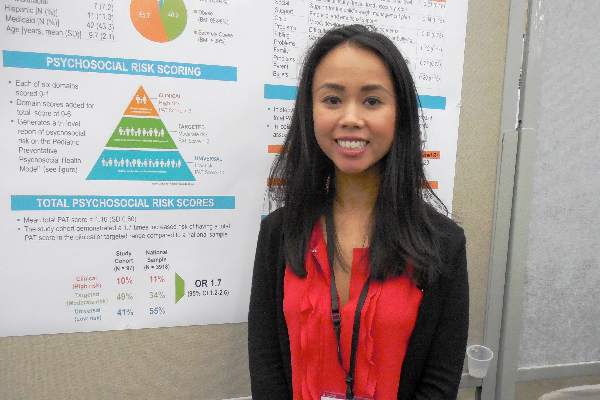AT THE PAS ANNUAL MEETING
BALTIMORE (FRONTLINE MEDICAL NEWS) – Childhood obesity can result from more than just poor diet, not enough exercise, and too much screen time; it also often occurs in families with parents who have a significantly increased prevalence of psychosocial problems, judging from findings from a pilot, single-center study involving 97 parents who brought their child to a tertiary-care pediatric obesity center.
This preliminary finding “supports the need for universal psychosocial screening in this population, with particular attention to families whose children have comorbid behavioral health problems,” Dr. Thao-Ly T. Phan said while presenting a poster at the annual meeting of the Pediatric Academic Societies.
“You might think that when a child is brought to an obesity clinic, you just need to ask what foods the child eats, how often the child exercises and how much television they watch, but we also need to ask about problems in the families and address those problems,” said Dr. Phan, a pediatrician and weight management specialist at the Alfred I. duPont Hospital for Children in Wilmington, Del.
Dr. Phan said although a key next step in this research is to assess how interventions aimed at family psychosocial problems affect a child’s obesity and well-being, her experience so far suggests that the psychosocial setting where a child lives can play a significant role in the etiology and maintenance of obesity.
“We find that families at higher psychosocial risk don’t come back for treatment, and when that happens the children don’t do well. That’s a reason to screen [for such problems] and intervene with psychological and social work support,” she said in an interview.
“A lot of our messages to families focus on things like screen time and eating more fruits and vegetables, but if the family can’t implement that, then we’re missing the boat,” Dr. Phan said.
She and her associates used the Psychosocial Assessment Tool (PAT), a screening tool for parents that takes about 5-10 minutes to complete and that was developed by researchers at the Children’s Hospital of Philadelphia ( ACTA Oncologica. 2015 May;54[5]:574-80 ). The PAT poses a series of questions that deal with a spectrum of potential psychosocial issues including financial status, a child’s problems at school, parents’ mood and substance abuse, and parental views of weight and health issues.
The investigators administered the PAT to 97 parents of children aged 4-12 years old who had their first visit to the tertiary-care pediatric obesity clinic at Alfred I. duPont. The children had body mass index levels that averaged close to the 99th percentile, with 56% of the children classified as severely obese with a BMI at or above the 99th percentile, 40% classified as obese with a BMI in the 95th-98th percentile, and 4% classified as overweight with a BMI at the 85th-94th percentile.
The PAT scores in these 97 parents identified 41% with a low risk for having psychosocial problems, 49% with a moderate risk, and 10% with a higher risk. In contrast, a historical control group of 3,918 representative U.S. parents who took the PAT showed 55% at low risk, 34% at moderate risk, and 11% at high risk, which meant that the parents of the children at the clinic had a statistically significant 70% increased prevalence of being in a high- or moderate-risk group for psychosocial problems, compared with parents in the general U.S. population, Dr. Phan reported .
A stepwise linear regression analysis of the PAT results identified two factors that significantly linked with higher PAT scores in these parents: attention- deficit/hyperactivity disorder in the child, and mood disorder in a parent. Logistic regression analysis further narrowed this down to just the child’s attention-deficit/hyperactivity disorder as the only significant correlate with higher PAT scores. The analysis showed that the severity of obesity had no significant correlation with psychosocial risk scores.
The next steps are to assess more parents of obese children this way, see whether the questions posed in the PAT can be better focused for this setting to make the screening simpler and easier to administer, and determine how interventions aimed at the identified risks improve child outcomes, Dr. Phan said.
Another goal of this research is to raise the profile of family psychosocial problems as an important factor in the development and maintenance of obesity in children, she said. “I think that people who work at pediatric weight management clinics have recognized the role of family psychosocial problems, but it is less recognized by the general pediatric community.”
Dr. Phan had no relevant financial disclosures.
On Twitter @mitchelzoler



